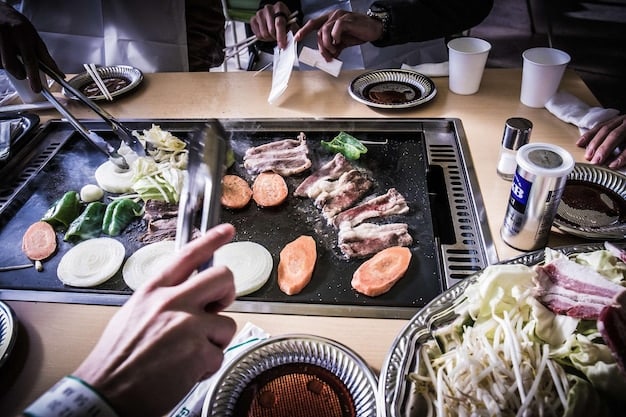Korean Cuisine Trends: What US Foodies Will Crave This Year

What’s New in Korean Cuisine Trends for US Foodies This Year? Expect exciting flavors like black garlic, advancements in Korean BBQ, creative fermentation, spicy seafood, and the fusion of K-food with American comfort foods.
Korean cuisine continues its rise in popularity, and what’s new in Korean cuisine trends for US foodies this year promises a thrilling culinary ride. Get ready to explore innovative flavors, techniques, and dishes gaining traction across the United States.
Exploring the Evolving Landscape of Korean Food in America
Korean food has become a staple in many American cities, with a diverse range of flavors and dishes that appeal to a growing number of food enthusiasts. From traditional dishes to modern interpretations, the scene continues to evolve, offering exciting culinary experiences.
This year, several key trends are shaping the direction of Korean cuisine in the US, influenced by both authentic Korean flavors and innovative fusion approaches. Here’s a glimpse into what you can expect.

The Enduring Popularity of Korean BBQ
Korean BBQ remains a beloved dining experience, with its interactive grilling and communal feasting. However, chefs are pushing the boundaries by introducing premium cuts of meat and creative marinades.
- High-Quality Meats: Restaurants are sourcing wagyu beef and Iberico pork to elevate the BBQ experience.
- Innovative Marinades: Experimenting with fruit-based marinades, such as pear and apple, adds a touch of sweetness and tenderness to the meat.
- Advanced Grilling Technology: Incorporating state-of-the-art grills that minimize smoke and optimize cooking temperatures.
Expect the evolution of Korean BBQ to offer a more refined and sophisticated dining experience for US foodies.
The Rise of Black Garlic in Korean Dishes
Black garlic, known for its sweet, tangy, and umami-rich flavor, is making its way into various Korean dishes. Fermented for weeks, this ingredient adds depth and complexity.
Chefs are incorporating black garlic into sauces, marinades, and even desserts, showcasing its versatility. Here’s how:
Black Garlic Infused Sauces
Black garlic is being blended into sauces for dishes like bibimbap and Korean fried chicken, enhancing the overall flavor profile.
Black Garlic Marinades
Used to marinate meats like bulgogi and kalbi, black garlic imparts a distinct savory sweetness.

- Elevated Flavor Profiles: Black garlic adds a layer of umami that enhances classic Korean dishes.
- Antioxidant Benefits: The fermentation process boosts the antioxidant content of black garlic, making it a healthy addition.
- Versatile Applications: From savory dishes to sweet treats, black garlic can be used in a variety of ways.
The integration of black garlic demonstrates the innovation occurring within Korean cuisine.
Creative Fermentation: Beyond Kimchi
Fermentation is a cornerstone of Korean cuisine, with kimchi being the most well-known example. However, chefs are now exploring lesser-known fermented ingredients.
These innovative culinary artists are broadening our palates with everything from vinegars to soybean pastes. These innovative spins add a unique depth to modern Korean dishes.
Beyond the Usual Suspects
While kimchi is still prominent, expect to see more dishes featuring fermented soybean paste (doenjang), fermented chili paste (gochujang), and fermented seafood (jeotgal).
Fermented Beverages
Traditional Korean rice wine (makgeolli) and fruit-based vinegars are gaining popularity as refreshing and probiotic-rich beverages.
- Enhanced Flavors: Fermentation deepens the flavors, adding complexity to dishes.
- Health Benefits: Fermented foods are rich in probiotics, supporting gut health.
- Preservation Techniques: Fermentation extends the shelf life of ingredients while enhancing their taste.
These fermented creations are sure to tantalize the taste buds and add an authentic flare to the Korean cuisine scene.
Spicy Seafood Sensations
Korean cuisine is known for its bold and spicy flavors, and this extends to seafood dishes. Expect to see more spicy seafood offerings that pack a punch.
Adventurous eaters can look forward to fiery flavors mingling with the freshness of seafood. Keep an eye out for these dishes.
Spicy Seafood Stews
Dishes like haemultang (spicy seafood stew) and agwijjim (braised monkfish with spicy sauce) are gaining popularity for their intense flavors and textures.
Spicy Grilled Seafood
Grilled squid, octopus, and shrimp marinated in gochujang-based sauces offer a delightful combination of smoky and spicy flavors.
- Flavorful Heat: The combination of seafood and spicy sauces creates a unique and addictive taste.
- Diverse Textures: From the tender flesh of fish to the chewy texture of octopus, spicy seafood dishes offer a variety of sensations.
- Nutritional Benefits: Seafood is a good source of protein and omega-3 fatty acids.
Spicy seafood is sure to become a hit with US foodies seeking bold and exciting flavors.
Fusion Delights: K-Food Meets American Comfort
The fusion of Korean and American flavors continues to evolve, creating exciting and innovative dishes. Chefs are blending traditional Korean ingredients with American comfort food staples.
This results in dishes that are both familiar and uniquely Korean. Here are a couple of examples.
Korean Fried Chicken Sandwiches
Crispy Korean fried chicken served on a soft brioche bun with kimchi slaw and gochujang mayo offers a delicious blend of spicy, savory, and sweet flavors.
Kimchi Mac and Cheese
Adding kimchi to mac and cheese creates a tangy and flavorful twist on this classic American comfort food.
- Familiar and Exotic: Fusion dishes offer a comforting yet adventurous culinary experience.
- Creative Combinations: Chefs are using Korean ingredients in unexpected ways, resulting in innovative flavors.
- Cross-Cultural Appeal: Fusion dishes attract a wide range of palates, bridging the gap between Korean and American cuisine.
These dishes are capturing the imagination of foodies nationwide.
Elevated Street Food Experiences
Korean street food is getting a gourmet makeover, with chefs elevating classic snacks with premium ingredients and innovative techniques. This new take combines the simple flavors of street food with upscale gastronomy.
This brings an adventurous take on street eats, without ever losing sight of the essential flavor pairings. Classic street food, brought up to modern tastes.
Gourmet Tteokbokki
Rice cakes in spicy gochujang sauce are elevated with ingredients like truffle oil, lobster, and artisanal cheeses.
Premium Kimbap
Korean sushi rolls are made with high-quality ingredients like wagyu beef, fresh uni, and organic vegetables.
- Premium Ingredients: Chefs are using top-notch ingredients to enhance the flavor of street food.
- Artistic Presentation: Elevated street food is often beautifully plated, adding to the dining experience.
- Nostalgic Flavors: While elevated, these dishes still retain the comforting flavors of classic street food.
Gourmet twists on street food brings some beloved snacks into fancy territory.
| Key Trend | Brief Description |
|---|---|
| 🍖 Premium Korean BBQ | High-end meats & innovative marinades enhance the BBQ experience. |
| 🧄 Black Garlic Dishes | Black garlic infuses sauces and marinades, adding sweet umami. |
| 🌶️ Spicy Seafood | Spicy seafood stews and grilled dishes with bold flavors. |
| 🍜 Fusion Cuisine | K-food meets American comfort, creating unique dishes. |
Frequently Asked Questions
▼
Black garlic’s sweet, tangy, umami flavor adds depth and complexity to Korean dishes. Its fermentation process boosts its antioxidant content, offering a health benefit too.
▼
High-end Korean BBQ restaurants use premium cuts like wagyu and Iberico pork. Innovative marinades, like fruit-based ones, are also a common feature of fancier BBQ.
▼
Popular Korean fusion dishes include Korean fried chicken sandwiches with kimchi slaw and gochujang mayo, and kimchi mac and cheese providing a tangent and flavorful twist.
▼
Yes, many of these trends offer vegetarian options. Fermented vegetables like kimchi are naturally vegetarian, and fusion dishes can often be adapted to exclude meat.
▼
Major cities with vibrant Korean communities such as Los Angeles, New York, and Chicago are great places to start. Also, look for innovative Korean restaurants near you.
Conclusion
As Korean cuisine continues to evolve in the US, foodies can look forward to a diverse and exciting culinary landscape. From the elevated flavors of black garlic to innovative fusion dishes, the trends highlighted promise to tantalize the taste buds and offer memorable dining experiences.





